« After the book | Main | Diving South Florida May 2016 »
July 15, 2014
Saba and St. Kitts, May 30 to June 7, 2014
It was a deal we couldn't resist, and after the unfavorable weather condition we had encountered on the same itinerary in 2010, we had intended to go back and do this trip over anyway. Saba and St. Kitts in the Leeward islands of the outer Caribbean, onboard Explorer Ventures' Caribbean Explorer II. Only this time we'd do the trip in reverse order, start in Saint Maarten and leave from St. Kitts.
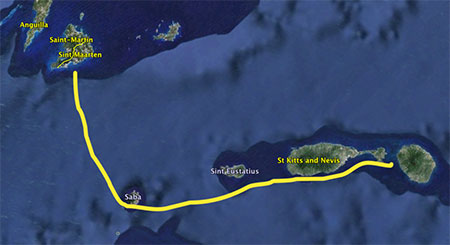
Getting there means a long trip from California. This time we took a shuttle flight to Los Angeles, a red-eye to Newark, and then it was another four-plus hour stretch to St. Maarten. Packing for a liveaboard dive trip is always a challenge because it's hard to anticipate what you'll need and what should be left behind. Having been on the same boat before made it somewhat easier. One doesn't need much clothing on a liveaboard. There is no dressing up for dinners or nights on the town. But if you forget something, there's little shopping to cover omissions.
I wasn't sure what wetsuit to bring. Last time we did this trip was in late summer, with water temperatures a steady 86 degrees. That meant even a 3mil wetsuit was too much and we did many dives in just bathing suits. This time the boat company predicted around 80 degrees, and divers know the big difference just six degrees can make. So I brought along my 5mil wetsuit. It's bulkier and I might get hot, but that's better than feeling cold and clammy on dives.
Saturday, June 1, 2014 Saint Maarten — We arrived at the modern St. Maarten airport shortly before noon on Saturday. The customs official determined that, contrary to the way we had filled out the forms, we weren’t actually going to stay in St. Maarten and it was a transfer. Still, immigration was quick, we got our luggage, and found a cab driver with a Caribbean Explorer sign waiting for us outside the airport. The taxi ride to the marina was longer than expected, winding through little towns and up and down the mountainous island which is half Dutch Saint Maarten and half French St. Martin. For that we were charged ten dollars per person and I gave the friendly cabby another five.

The Caribbean Explorer II was moored in Bobby's Marina and we were greeted by some of the crew. We couldn't board yet because the rooms weren’t quite ready, and so we decided to explore St. Maarten for an hour or two, until the 3pm boarding time. It was cloudy, hot, and stiflingly humid. We meandered around the boardwalk with its palm trees, made our way through the narrow little alleys with their endless souvenir shops and stands with insistingly peddling locals. That was in stark contrast to tourists perusing Cartier fashions and Rolex watches in luxurious designer stores. St. Maarten felt a bit seedier than we remembered, but maybe it was the lack of sleep and the heat and humidity. We should have had a drink and some local fare in one of the many tropical looking bars. But, unable to make a decision, we went with Subway sandwiches instead and ate them outdoors in the heat.
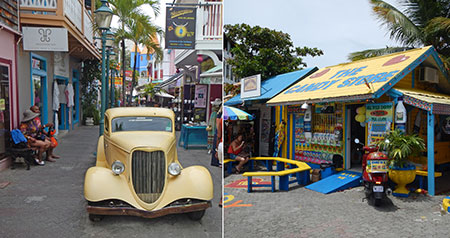
We were back at the boat around three, set up our dive gear, and got acquainted with the staff. This time we had stateroom #3 on the main deck, which was far more convenient than the downstairs cabin in the front of the boat we had had on our first trip on the CEX II. Our new accommodations had a queen bed at the bottom and a twin bunk on top of it. There was large storage under the bed and we could also use the upper bunk to store more of our stuff. The room was a bit smaller than the cabin we'd had on the lower deck, but it was nice enough. There was a sink in the cabin, and we had a separate shower with a toilet. There was only one power outlet, though, and so I was glad we had brought a 7-port USB charger and an outlet multiplier. Unlike on our prior trip, the A/C definitely wasn't a problem this time and the cabin was, and stayed, almost icy cold. Last time it had been humid and too warm.
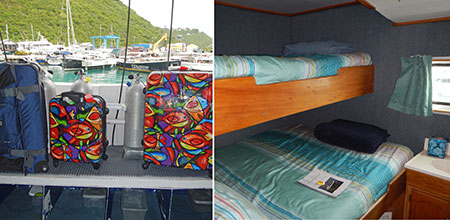
It is always interesting to meet the crew. This time it consisted of just five. There was the charming and very personable purser/divemaster Maria who had worked on the Honduran island of Utila and also on liveaboards; divemaster Martin, a young man from Belgium; engineer Charles, a friendly and helpful ex-Navy man; cook Jane and captain Ian, both of whom had been on the boat last time. A crew of five is marginal and apparently a couple of staffers had canceled or were unaccounted for. As it turned out, the skeleton crew worked hard and never missed a beat. Purser Maria also was divemaster and waitstaff, Ian helped with serving, while engineer Charles helped on the dive deck, and Martin was divemaster and managed the dive deck. It can be done with five staff for 17 guests, but it cannot be easy.

We’d barely finished settling in (and received an explanation of the room emergency and safety systems by engineer Charles) when it was already time for dinner. Cook Jane prepared deliciously tasty steaks on the barbecue on the upper deck, accompanied by asparagus, cauliflower, potatoes and salad. For dessert there was vanilla ice cream with rum cake and fruit. You never go hungry on a liveaboard, and the food is good and plenty. You never go thirsty either. The CEX II has a well stocked bar with all sorts of liquor, red and white wine, plenty of beer, and also a soda dispenser system. In addition, of course, to juices, numerous teas, milk and water.
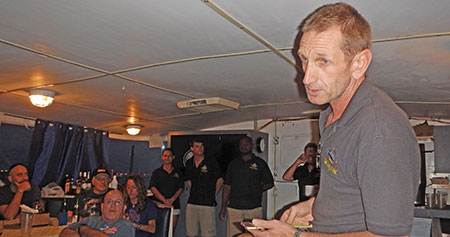
After dinner, Captain Ian introduced the crew and did an overview of the ship and its operation. At 8pm the boat left St. Maarten for the island of Saba. The captain had warned of a rough crossing, but it wasn't all that bad. Carol and I went to bed at 8:30 and slept great all through the night.
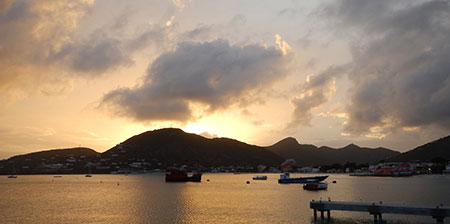
Sunday, June 2, 2014 Saba — I woke up around six o'clock on Sunday morning, and saw the boat was anchored close to the almost vertical rock wall of Saba. There was a slight breeze, the temperature was pleasant, and actually welcome after the rather cold cabin. I went upstair, got coffee from the boat’s new machine that upon pushing a button dispenses excellent coffee and even espresso. Breakfast began at 7, with eggs and sausage to order, and there were also bagels, rolls, cereals, yogurts, juices, and more.
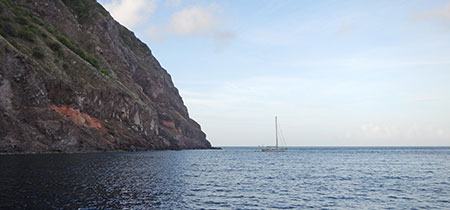
At 7:45 the captain did a general briefing on the rules of diving on the CEX II. 130 feet maximum depth for those on air, 110 feet for those on nitrox (which was the majority of the guests). Maximum dive time 70 minutes, no gloves, no touching, always diving with a buddy. No need to change tanks after every dive; the crew fills them with the air whips installed on the dive deck. There is a dive briefing before every dive, and we’d be alerted to it by the blowing of the conch (which sounds like a fog horn).
Then divemaster Martin blew the conch and did the first dive briefing of the trip. The first dive was at Ladder Labyrinth a brief distance off the rocky slope of the island. The water seemed rather clear — a huge difference from our last trip where we had to descend the anchor line through 30 feet of murk. We jumped in the water and clearly saw the bottom from the surface.
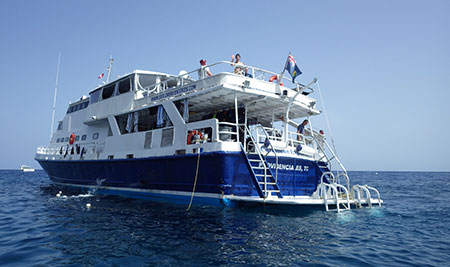
The water temperature was a nice 81 degrees. I was the only one on the boat who wore a 5mil wetsuit and wondered if perhaps that was too much, but at least on this first dive it felt just about right. I had started with 14 pounds of weight, and that did not seem quite enough, especially towards the end of the dive. For some reason I always need more weight than one would expect. Right underneath the boat there were a few large tarpon that seemed totally undisturbed by us divers.
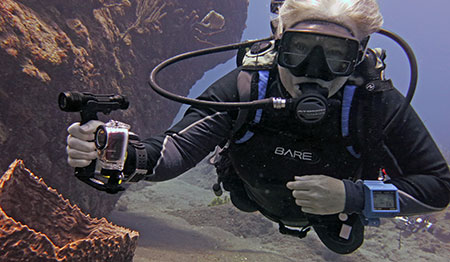
The dive itself was very nice. We saw an attractive mix of coral heads, coral islands, and coral fingers through which we meandered at depths ranging from 40 to 80 feet. I had a brand-new mask and, despite extensive cleaning beforehand, it remained fogged up during the entire dive, impairing vision. I should have known better. We saw a pair of goofy-looking and very tame large puffers, a few tiny juvenile spotted drums, and the usual assembly of Caribbean aquatic life, though nothing exceptional. It turned out to be an 80-foot one-hour dive.
The Caribbean Explorer II has two weights hanging off its stern at 15 feet. These can be used to hold on during the mandatory three-minute safety stops. I did that, and was treated to a nice ride as the boat drifted around its mooring line.
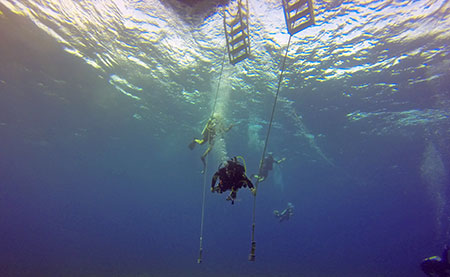
Getting back on the boat means grabbing one of the two very sturdy ladders onto the lower dive deck, handing the waiting divemaster fins and camera, negotiating the few steps  first onto the dive platform and then the dive deck, giving the captain your maximum depth and remaining air pressure, then taking off the gear. Particularly nice are the two warm shower heads on the dive deck. There's nothing like a hot shower after a dive, to get the salt off and warm up. And since you work up an appetite when diving, Jane had baked banana bread which made for a tasty snack between dives.
first onto the dive platform and then the dive deck, giving the captain your maximum depth and remaining air pressure, then taking off the gear. Particularly nice are the two warm shower heads on the dive deck. There's nothing like a hot shower after a dive, to get the salt off and warm up. And since you work up an appetite when diving, Jane had baked banana bread which made for a tasty snack between dives.
I noticed that, while last time we hadn't seen another boat the whole trip, this time there were several smaller sail boats anchored along the coast of Saba.
The second dive was again at the Ladder Labyrinth dive site. In her briefing, divemaster Maria told us of the presence of hot sand underwater, thanks to Saba’s volcanic origin.
Once in the water, she set a nice slow pace, there was plenty of sun, great visibility, and a balmy 82 degrees. We mostly stayed shallow, leisurely diving around all those gorgeous coral heads. Maria showed us the strips of warm sand that you could tell by their orange color. The sand isn’t really hot, but nice and warm. It’s a very nice dive site, and so close to the shore that I wished we could have approached the rock face of the island.
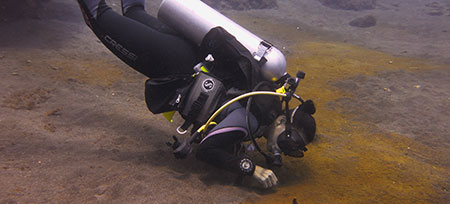
At home, breakfast and snacks would leave me plenty filled up till dinner, but when diving you’re always really looking forward to lunch. Steak meatballs, salad, a tasty curry soup, and tortellini and other pasta really hit the spot.
For the third dive the captain moved the boat a short distance to the “tent†sites, so named after a tent-like formation on top of the rocks on the surface. For this dive, the mooring line was anchored on top of an underwater wall, but the CEX II was floating over deep water, and so we had to descend along the mooring line.
Despite having added two pounds of weight, I still had a hard time getting down, and once I was, my Canon G15 camera acted up. That aggravated me to an extent where I missed enjoying part of the dive. The wall reminded of the Roatan walls, with beautiful barrel sponges and lots of the bright yellow sponges that are my favorites. We even saw a reef shark in the distance. At the end of the Tent Wall site the wall gives way to the Tent Reef site, and so we turned around and swam back on top of the wall. Unfortunately now against a rather strong current that necessitated ascending along the mooring line again. My ears acted up a bit, too, probably going back to the problem descending.
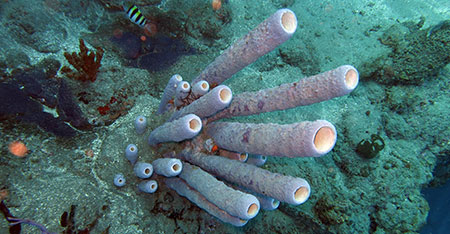
On the boat, a bowl full of warm chicken taquito flutes awaited us and made me forget the hassle with the camera.
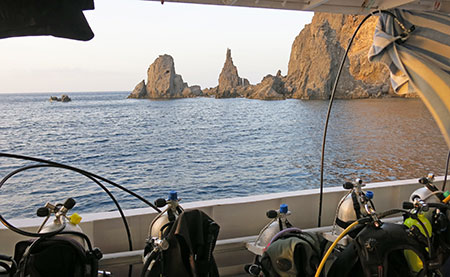
Then it was time for the fourth dive of the day. Torrens Point had been a bust on our last visit. Visibility had been virtually nil and we hadn’t see anything and quickly came back up. This time the site was gorgeous. The area is 30-45 feet of mixed sand, coral heads, coral fingers, with lots of life of all sorts. We did see a number of conch and other shells that some irresponsible divers had harvested and discarded, quite illegally as we were diving in Saba’s marine park. We took pictures of the heinous crime, both stills and video. Other than that, it was a pleasant leisurely dive with nice light, though it was getting darkish towards the end of the dive. I had taken along a GoPro 3 with dual LiquidImage lights and BackScatter filters, and experimented with the 30 to 50 feet filter.
For dinner, Jane served spinach-filled chicken breasts, sweet potatos, broccoli and salad, and then topped it off with a date-cake and vanilla ice cream.
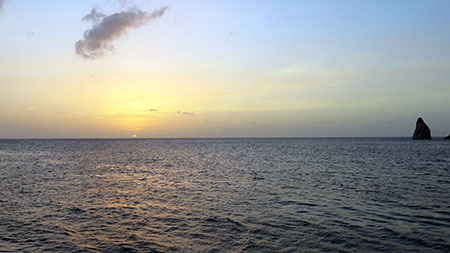
We skipped the night dive, though it probably would have been wonderful in clear water at Torrens Point. A school of very large tarpons were circling the ship, attracted by the light.
Gazing at the scenery from the upper deck and marveling at the good fortune of being on that wonderful boat in that wonderful place of the world, I mentally contemplated a few observations:
Last time we'd been hot all week and never wore any long shirt or shammy or anything warm. This time, with somewhat cooler weather and the strong A/C in the rooms, there was almost a rush to the ship's store where they sold hoodies and chammyz. So always be prepared. You simply never know beforehand what you’ll encounter temperaturewise
Second, while the much smaller cameras we use today aren't anywhere near as bulky as older gear, they come with so many cables, batteries, chargers, filters and other add-ons and gizmos that it quickly becomes overwhelming. With one camera it's okay, but with multiple ones it can become a nightmare to find and organize everything. What seems like manageable neatly spread out on the living room floor becomes a flood of things to keep track of on a boat.
Third, things that you'd never think would break will. Like my toothbrush. It snapped straight in half. That never happened to me before. Then again, I also had a pair of reader glasses fall apart during a major presentation I gave a few years ago in Stockholm. Another thing that unexpectedly broke was the band of my Uwatec SOL dive computer. I didn't expect that either.
And, of course, I did forget something -- the charger for my Nikon AW110 camera.
I also learned a new trick. To get the wetsuit on more easily, wet your arms and then put some soap or shampoo on them. That way they slither right in, well almost. Fortunately, the CEX II had a soap dispenser right on the dive deck.
Mooring lines often have all sorts of growth on them, especially if they've been in the water for a long time. Touching them is never a good idea, but it cannot be avoided in poor diving conditions. So even if gloves are not allowed, I'd insist on wearing a thin pair to keep fingers and hands from getting stung and infected. Just take them off once you've reached bottom.
Monday, June 3, 2014 Saba — I woke up Monday morning at 6am (which was just 3AM California time!), seeing the island of Saba through our cabin window. I had slept great, as always on a boat. I had some coffee, perused the massive rock face of Saba, and took pictures of the old custom house and the stairs leading up to it. There’d been a time when this was the only way to enter Saba, and anything that was brought ashore had to go up those steps and needed clearing at the custom house. We’d learn more about that later.
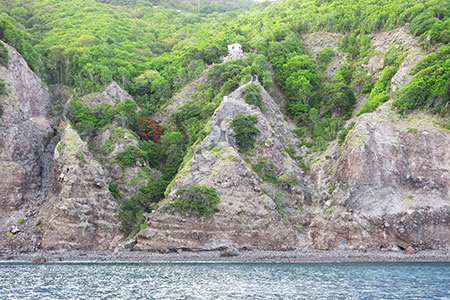
Our two morning dives at Tedran Wall, a site we hadn’t been before. Tedran stands for Ted and Randy, the divers who had discovered the site. It was a fairly deep drop to the top of the wall at 70 feet and so most of us went down the mooring line the first time. The wall itself was spectacular, with dramatic scenery in very clear water. We saw very little damage, large sponges and tons of other vegetation, including a great deal of that spindly black growth that was very pretty. I thought it was coral, but probably not. Above the wall were steeply sloping chutes that in some areas extended into the wall. There were large, beautiful sand dollars, Carol saw rays, and the only bad thing was that the dive was so deep that we ran a bit short on air (not Carol, of course, she surfaced with half her tank), and so started ascend the line at 35 minutes or so.
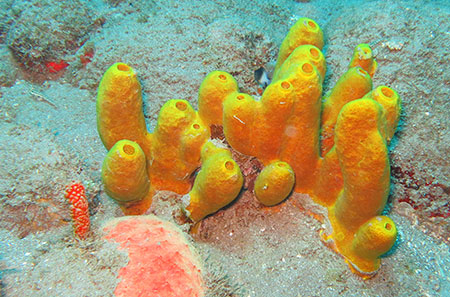
The second dive at Tedran was not quite as clear and current began to build. So instead of cruising along the wall we stayed on top of the reef and explored all the sand chutes and coral heads.
Between dives, Jane surprised us with delicious fluffy meringue coconut cookies. There was enough time to enjoy them as there are fairly long intervals between the dives on the CEX II, long enough to take off the suit, dry off and recover.
Two things happened that morning. One of the divers had a pony bottle since he dove solo, and the bottle and regulator attached to it apparently came loose and fell off into the abyss when he jumped in. The pony bottle was the ship's and neither Maria who made a recovery attempt, nor anyone else on the second dive at the site found it.
Another diver, 73-year-old Maurice who dove air, disregarded his computer's deco order and so the computer locked up on him. He was not allowed to dive for 24 hours, until the computer said it was okay.
 For lunch we had chicken Fajitas with giant tortillas (and yes, I am reporting on all meals to present a picture of what the culinary experience is on a diveboat like the CEX II). The captain informed us that he'd take the boat up to Diamond Rock to see what the conditions were for diving. He also told the story of the Saba Custom House perched high up in the rocks, with 300 steps steeply leading up to it, with most of the steps still there and visible from the boat. Until the 1950s, Ian said, this was the only way to get on Saba (which seems almost unlikely) and whatever goods and materials were brought to Saba had to go up those stairs for examination, registration and duty. I'd love to get on land and hike up those steps.
For lunch we had chicken Fajitas with giant tortillas (and yes, I am reporting on all meals to present a picture of what the culinary experience is on a diveboat like the CEX II). The captain informed us that he'd take the boat up to Diamond Rock to see what the conditions were for diving. He also told the story of the Saba Custom House perched high up in the rocks, with 300 steps steeply leading up to it, with most of the steps still there and visible from the boat. Until the 1950s, Ian said, this was the only way to get on Saba (which seems almost unlikely) and whatever goods and materials were brought to Saba had to go up those stairs for examination, registration and duty. I'd love to get on land and hike up those steps.
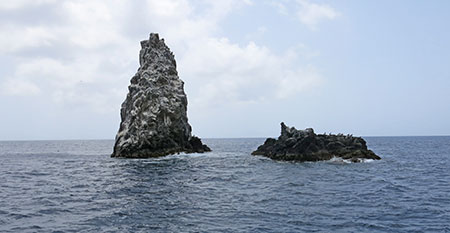
The first afternoon dive was indeed at Diamond Rock as the conditions turned out to be good. Diamond Rock, one of Saba's signature dives, is a twin volcanic spire emerging from flat sand at 75 feet, and rises above the surface by maybe another 75 feet. The boat moored close by the rock and the water was clear enough to just jump in and slowly descend towards the base of the spire. Once there, we began a one-turn clockwise rotation, encountering strong current in some spots and almost nothing in others. The view was spectacular, with gorgeous, large growth everywhere, myriad of aquarium fish doing their thing, and wonderfully clear water. We should have stayed in one of the calm spots as there was enough to see for hours.
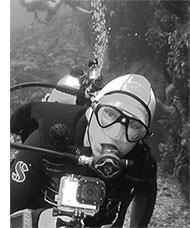 During the dive I kept hearing an unusual noise. It turned out that my tank valve was bubbling pretty badly, so much so that Carol was concerned about my air (and when I later looked at it on video it looked quite scary). It didn't go down alarmingly fast, though, and so I just kept a close eye on it. Unfortunately, the current was very strong right at the spot where we were supposed to head back for the boat, and so there was no staying and taking in the wondrous sights. The swim back through essentially blue water was hard, with current strong enough to make me pant.
During the dive I kept hearing an unusual noise. It turned out that my tank valve was bubbling pretty badly, so much so that Carol was concerned about my air (and when I later looked at it on video it looked quite scary). It didn't go down alarmingly fast, though, and so I just kept a close eye on it. Unfortunately, the current was very strong right at the spot where we were supposed to head back for the boat, and so there was no staying and taking in the wondrous sights. The swim back through essentially blue water was hard, with current strong enough to make me pant.
Since, for us, all dives were work dives where we evaluated underwater camera gear and equipment, Carol had taken along a LiquidImage EGO and I a GoPro Hero3 mounted on an orange stick with Backscatter’s “deep†filter.
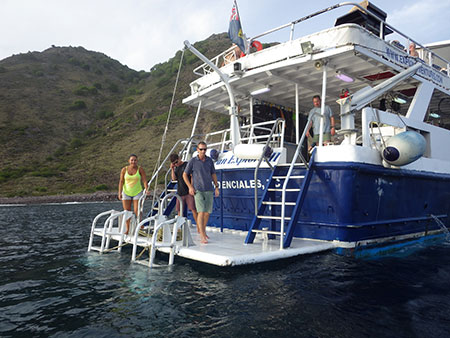
Carol and I skipped the second Diamond Rock dive and napped instead. I uploaded video and we examined the rather disappointing results. Underwater video and photography are never trivial.
Dinner was barbecue night with ribs!
One of the great things about liveaboards is that there aren't any bugs. These can thoroughly spoil any land-based vacation as we found out repeatedly in Roatan, Cozumel, Florida and other places. This time, however, Captain Ian warned of a “bug hour†where tiny non-biting but very pesky insects descend upon the ship — sometimes in great quantities — then die off an hour or two later. We didn't experience this last time we were on the CEX II, but as is the lights were dimmed and the plastic windows of the upper deck closed. The bugs arrived indeed, but it was no big deal.
I decided to finally do another night dive. I didn't really want to, but I felt I'd probably regret it later if I didn't do at least one night dive. I rarely feel comfortable on night dives and so didn't know what to expect. I took along three lights, the two Liquid Image torches on a base and pistol grip, and a backup light. Since Carol didn't come with, I followed dive master Maria closely.
It turned out to be a very nice experience. Slowly floating around the shallow (30-45 feet) coral reef with our lights was kind of a magical experience. I was nice and warm, thanks to the 5mil wetsuit at 82 degrees, and we saw all sorts of creatures that usually hide during the day. That included two nurse sharks and numerous spiny lobsters that were out of their daytime hiding holes. We had been warned that there was a chance there'd be sea wasps upon our return. If the boat spotted any, they'd lower a red light for us as a warning. We'd then have to use the octopus to blow up some air to make them go away for our ascent. Fortunately, there weren't any. And by the time I got back up on the boat, the bugs had all died off.
Another wonderful boat thing: hot chocolate, Baileys and Kahlua awaited us. After drying off and changing into regular clothes, Carol and I resorted upstairs for some popcorn and conversation with Jane. Jane’s from England, has always been a world traveler, and took up the nomadic Caribbean life a decade or so ago.
Tuesday, June 4, 2014 Saba — Woke up at 6AM again on Tuesday morning, to the same balmy temperatures and somewhat hazy ski — not cloudy, not overcast, just somewhat hazy. It was not as bad as that sounds because the relative lack of light in the morning was because the sun hides behind the massive bulk of Saba.
As I enjoyed a cup of coffee upstairs, the boat moved away from its mooring close to the island to a dive site about a mile away from shore. That's where Third Encounter is, a ledge at 90 feet or so, and beyond that the abyss. A shortish swim away from that is the Eye of the Needle, a skinny spire that rises up to within 90 feet of the surface, but which isn't visible from the ledge even under the best conditions. This is a Saba signature dive, but one that I ended up not making. I like deep dives, but on nitrox and having to swim to and from a peak that tops out at 90 feet below the surface means very little bottom time and lots of descending and ascending in the blue, neither of which appeals to me.
I did feel a bit like a wuss as everyone else, except Maurice whose dive computer was still locked, did go. A brave group we had, and that was not surprising as on this trip, there really weren't any inexperienced or marginal divers. So I concentrated on taking pictures of the boat and divers entering the water. Carol, as always, was the only one doing a forward roll.
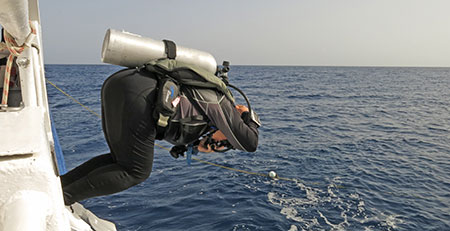
As it turned out, the divers reported excellent visibility and no current, so that the dive had been terrific. Carol went down to 110 feet and still brought back 1,600 psi on a 43 minute dive. She said you could almost see the spire from the ledge and that it had been marvelous. Oh well. Next time.
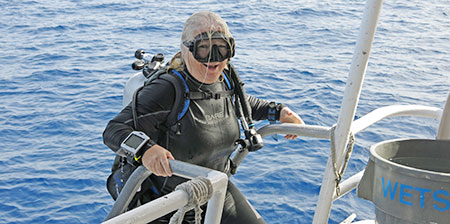
We then did two dives at Tent Reef. The site is a large area that includes everything from gorgeous shallow reeftops, to endless meandering swims between all the coralheads, to wall-like structures, to large expanses of garden eel sand. Part is luscious, colorful and undisturbed. Other parts are covered with silt. I wondered why the large difference between the silted and the clear areas. My air consumption was considerably better after the crew replaced the bubbling valve stem insert on my tank. No more bubbles.

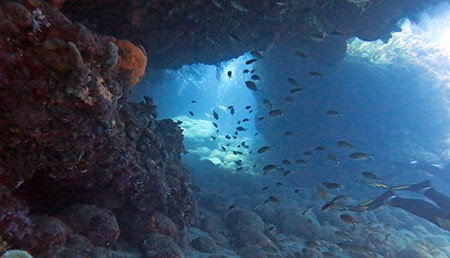
For lunch, cook Jane had prepared chicken and shrimp patties, burger style, with chips, salads, and condiments.
We cut the second Tent Reef dive a bit short in order to board the dinghy that brought us to shore for a tour of the island of Saba. That required two trips. All nine of us then piled into the same old microbus taxi driven by the same cab driver, Garvin, we’d had last time.
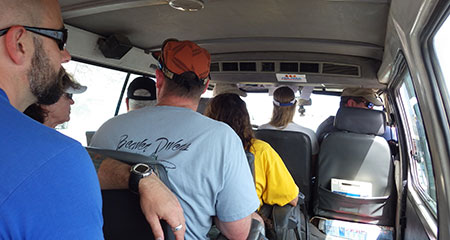
The road-that-could-not-be-built (according to a Dutch engineer back in the 1950s or so, supposedly) was fun, we saw the church again where a proper Dutch school marm prepared children for a religious ceremony.
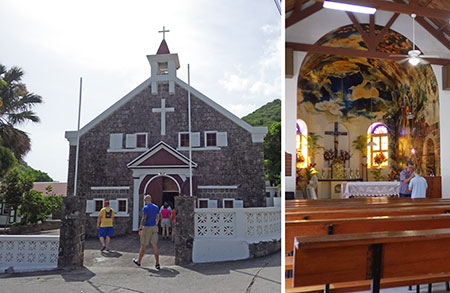
We visited the embroidery shop and bought a little piece of embroidery and some local liquor. Saba, supposedly, was once known as the Island of Women as the men were always away fishing. To pass the time they took up embroidery and developed it into an art form that lives on today.
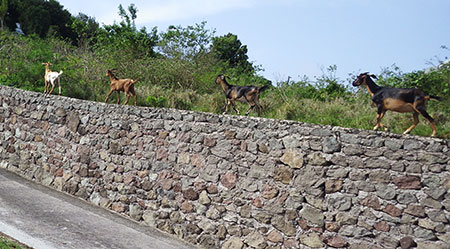
The van then took us up higher into the hills from where we could look down onto one of the small towns nestled into the valley. When viewed from the sea, it looks like Saba isn't inhabited at all. Wild goats are seemingly everywhere.
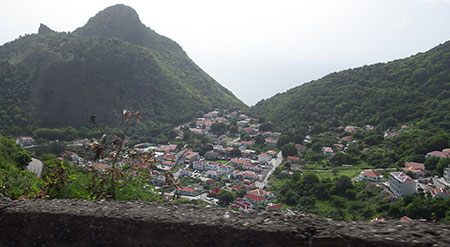
We then visited a glass shop with some wonderful artwork, then on to a place where we could overlook the airport with its impossibly short runway that stops at the cliff.
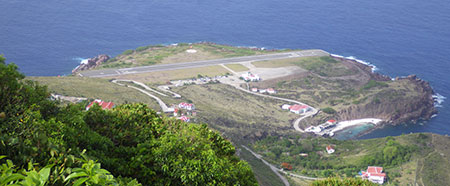
The cab then dropped most of us off to descend the old step trail down to the small town of Windwardside where we got drinks and shopped some more. The trail was steep, made of cement and stone and a bit on the slippery slide. It ran through lush tropical forest, thankfully devoid of insects. Good thing I had put on my sneakers. In town Carol shopped for some items, I bought some Pineapple Fantas in the little supermarket, and the others had beers at a bar.
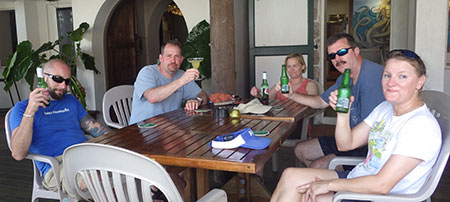
Overall, it felt like Saba had gone downhill a bit since we’d been there in 2010. I had expected the opposite as Saba was now no longer part of the Netherland Antilles but a direct part of the Kingdom of the Netherlands, but the island seems severely cash starved. The famed red roofs of Saba are as eye-catching as ever (though they're really just corrugated metal), but a lot of construction is unfinished or in need of maintenance. It often looks as if there had been an economic boom once the roads were completed in the 1950s and 1960s, but that not much has happened since. Which, of course, may be a good thing.
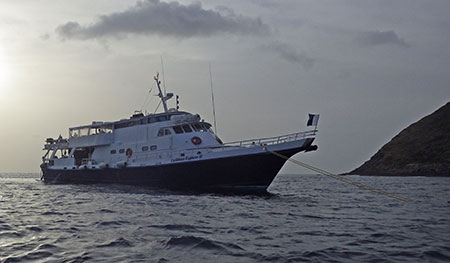
Upon return to the boat, which gave me a chance to shoot some pictures of the CEX II from the water as we approached, dinner was served, and it was another meal one would simply not expect on a relatively small dive boat: tender, tasty sirloin or fillet with mushroom sauce, rice, peas, carrots, and salad. For dessert there were hot brownies with ice cream. Then it was time for the three-hour passage to the island of St. Kitts, and taking assessment of our work so far
Our camera testing, we had to realize, had been dismal. We forgot the charger for one of them (the Nikon AW110), the Canon G15 had weird controls and white balance and is way off as often as on target, the two GoPro 3s produced very disappointing video even with filters, way, way worse than what one of the guests (Penny) managed with her Hero3+. I wondered if the newer GoPro Hero 3+ had a fundamentally better white balance than the older Hero 3.
Wednesday, June 4, 2014 St. Kitts — The crossing on Tuesday evening from Saba to St. Kitts took the expected three hours and went very smoothly. We went to sleep early, like 8:30 or so, and woke up Wednesday morning at St. Kitts, to a somewhat hazy sky (Garvin the cabbie had said the haziness was dust from the Sahara). Still, the island of St. Kitts looked lush and, unlike what one sees of Saba from the sea, St. Kitts shows quite a bevy of development, with lots of housing, many churches, roads, etc.
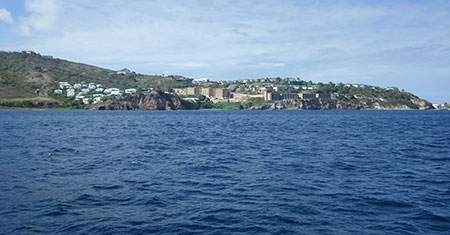
Our first dive was at “Paradise Reef†which — even this time — perhaps doesn't quite deserve its name. The site starts at a sandy slight slope at perhaps 40 feet with many small coral islands, then drops via large coral fingers down to another sandy area at 85 to 100 feet. The coral is often overgrown with some green leafy, meshy stuff that’s not very attractive. We saw a large lion fish, many fish traps (since St. Kitts is not a marine park), a couple of anchors and old timbers and ropes from St. Kitts vast maritime history, a few small southern stingrays, and plenty of little reef fish, plus a couple of large barracudas.
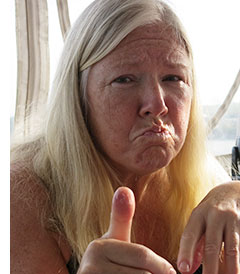 Carol's thumb had become all swollen from contact with fire coral from the mooring line at Tent Wall in Saba. My fingers ached a bit, too, from contact with those lines. It’s best to bring gloves whenever using those lines!
Carol's thumb had become all swollen from contact with fire coral from the mooring line at Tent Wall in Saba. My fingers ached a bit, too, from contact with those lines. It’s best to bring gloves whenever using those lines!
For lunch we had three different kinds of pizza, mango and melon, salad, and assorted beans.
I asked Maria why the good ship CEX II appeared to be listing to the right by perhaps four degrees and she said there were many theories about that. Four years ago I did not note any list. Carol said the captain had attributed it to a ballast distribution issue that needed fine-tuning.
The afternoon dives were close-by, at “Anchors Away.†Captain Ian said that was because when the English and French were battling it out, whoever was in the boats (the English and the French battled often) would yell "anchors away" when they saw the other party getting the cannons ready at Brimstone Fort. I am not sure if that was indeed the case, or if it was another of the captain’s straight-faced stories.
As is, the drop to “Anchors Away†was fairly large to the top of the reef, and from there it goes down to 75 or 80 through coral fingers until another large sand area. We didn't have much sun, so the site wasn't as attractive as it could be, but it also seemed a bit beaten up and covered with the mesh algae. There was considerable surge back and forth, and it seemed like most of the dive we were fighting against current, which became frustrating.
I did see two large lionfish, a reef shark, and perhaps the largest lobster I had ever seen, right on the reef top under the boat.
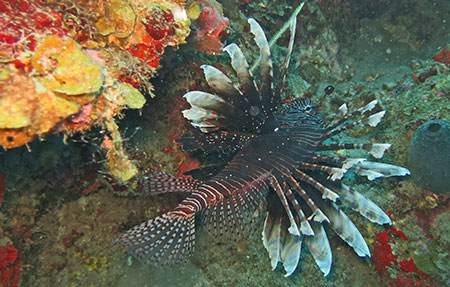
Back on the CEX II we found cheese and crackers as a snack, and, as usual, there was ample time to change batteries and upload video and pictures. Carol skipped the forth dive of the day, but I decided to go. On this second dive to Anchors Away we had much less current and surge and it turned out to be a nice, leisurely dive. I really like dive master Maria's pace.
Highlight of this dive was a standoff between a large lobster almost all the way out of its hole and three large lionfish facing the lobster. The lobster batted at them with his long antennae, and it wasn't quite sure what was going on. One does not usually see multiple lionfish in the open. But the lobster looked like much too large a prey for the lionfish.
Once back on the boat, we were treated to a gorgeous scenery with dramatic clouds on the horizon and you could see not only the northern end of St. Kitts but also the island of Statia, and even Saba, in the distance.
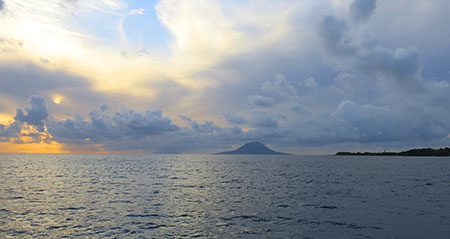
This evening those who ate seafood (which was everyone except Carol and myself) were treated to freshly caught fish that a fisherman from St. Kitts brought to the boat and cooked on the grill. I still often wonder how divers can eat fish (or catch lobsters) because watching those fish brings us so much pleasure and it seems inconceivable to eat them.
After dinner I went to the front of the boat where there were no lights and it was peaceful and dark. I wasn’t alone, though; there was Mike, who is 38, used to work for Lehman Brothers, and went to Japan for a long weekend last New Year's. He told me all about it. From the island we heard very loud preaching and music that went on for hours.
Thursday, June 5, 2014 St. Kitts — On Thursday morning there were dramatic clouds over the island of St. Kitts, and also over neighboring Statia in the distance. It rained a bit on and off, and the effect of it all was just wonderful.
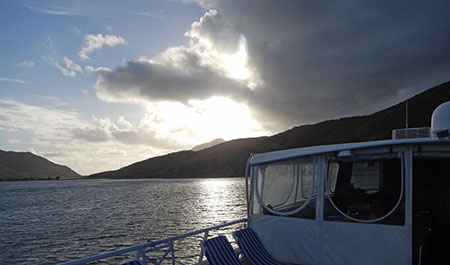
For diving, the captain moved the boat halfway up St. Kitts to an area called Old Road Bay where supposedly the first Europeans landed and settled. It received its name from one of the first roads built along the coastline. In more recent history the area had had quite a bit of fishing activity and there were many fish traps at the bottom, making diving inadvisable. There captain said there are far fewer traps now as the locals apparently moved them elsewhere.
To dive this site, we dropped to a sandy area at about 50 or 55 feet, from where we meandered through and above coral islands and sandy areas. The reefs were pristine, with just a bit of the green mesh algae. We saw a surprising number of morays, many of them free-swimming. There were also very tame large puffers that just sat there when we photographed them, and if we came too close they just slowly swam away. We had hoped to see some frogfish, but didn't find any.
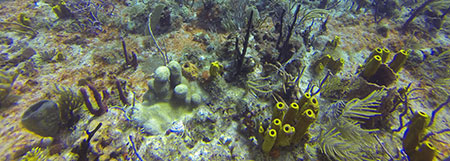
The boat needed to drop the anchor at Old Road Bay as there were no mooring lines. That means it swings around its anchor, making it difficult to locate its presence in low visibility. On the first dive we had clear water at the bottom and the boat was easy to find. We did the second dive at the same spot, but in much murkier conditions. We saw a giant turtle and, at the end — finally — a frog fish, and the boat was much harder to find in the reduced visibility. I had no idea where it was, but divemaster Maria listened for the sound of its engines and located it right away.
By and large, though, conditions play a far larger part in how much one enjoys a dive site than anything else. An unexceptional site in perfect conditions can be far more fulfilling to dive than a great site in bad conditions. You could also argue that ocean dive sites tend to be much the same in different parts of the world. The local fauna and sea life may change and vary a bit, but overall it's hard to differentiate between, say, a nice reef in Roatan from one off Providenciales, from one off St. Kitts or Saba. Same for walls. What sets them apart is the condition, variety, and the visibility and weather. Walls are different from the flat top of coral heads, of course, but what matters almost more is the depth. Closer to the surface there is more light, more sun, more color than down deeper. It's nice to occasionally go deep, but much of the attractive scenery is in shallower water. For that reason I prefer shallow reefs.
For lunch there was — surprise — another excellent meal: chicken kebabs, hummus, pita bread, feta cheese salad, peanut sauce, asparagus salad, and wild rice.


In the afternoon we dove the wreck of the Corinthian. We had visited it twice in 2010 and those had been enjoyable dives with very good visibility. I love wrecks and had looked forward to seeing the Corinthian again. Unfortunately, once we jumped in it was immediately clear that the conditions were nowhere near as good this time. The water was murky and we had to go down the mooring line. Once the wreck came into view it cleared up some, but the water still looked like we were in a snow storm. I began shooting video of the wreck, or so I thought, as the GoPro had somehow set itself to photography instead of video and I had wasted half a pass around the wreck. I tried again but by now the divemaster was already heading away from the wreck and disappearing in the snow storm. That's when I noticed that the LCD screen of the camera had gone out, with just a faint red light showing. I tried to turn it off but it did not respond at all and just kept recording.

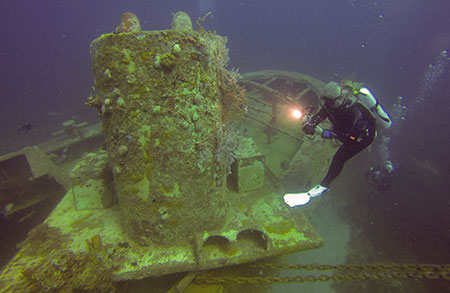
We negotiated the spread-out dive site, with swims through meadows of seagrass and somewhat silty slopes. We saw part of a sunken barge located a ways away from the Corinthian, then a sunken crane and, up on top of a sand chute a big bulldozer or crane, then made our way back through seagrass to the wreck, and then back up to the surface.
Given the water conditions we skipped the 4th dive. It would have been nice to return to the wreck of the River Taw where four years ago, in very poor visibility, I had lost the group and then had waited for them on what turned out the wrong mooring line. I had looked forward to the chance of seeing that wreck again in good visibility, but sometimes conditions just don't cooperate.
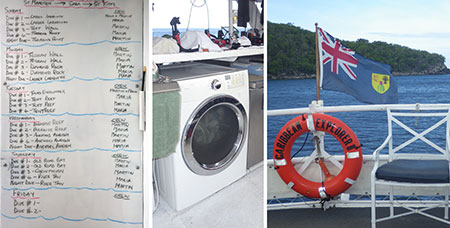
So I used the time to go over all of our cameras, changing batteries, uploading pictures, testing settings, and so on. Overall, none of the cameras had performed very well for us at all on this trip and I was reminded once again just how tricky underwater imaging can be.
For dinner we had truly exceptional pork loin, potatoes au gratin, corn, brussels sprouts, salad, and — as a big surprise — both a birthday cake for Carol and an anniversary cake for us! That was sweet and totally unexpected. I also received a congratulatory certificate for my 300th dive!
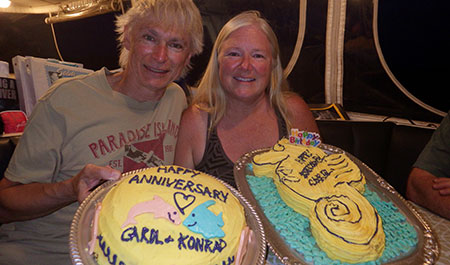
Captain Ian then informed us of what was going to happen for the rest of the week. Like us, the captain seemed to have a much better time than on the 2010 trip with its challenging weather and water conditions. He was relaxed, funny, and his dry wit and genuine concern for passengers having a great time was obvious. I can only imagine the load that must rest on a captain's shoulders.
For this night the boat was moored in what the crew called the “bedroom bay†where, for the first time on the trip, we didn't have any rocking at all.
Friday, June 6, 2014 St. Kitts — Friday morning we woke up after a mediocre night’s sleep. One of the passengers had mistaken the toilet bordering our state room for a phone booth in the night and proceeded to have a long, loud argument with some unfortunate party. I wish people would leave their cellphones behind on trips like this.
I wasn't sure if I wanted to do another dive because drying dive gear takes so long and with today’s pesky airline luggage regulations you can’t risk packing any extra water weight. But the weather was nice, the water looked clear, and I had good memories of the Monkey Shoals site between the islands of St. Kitts and Nevis where we were now moored. So I dove without the wetsuit, wearing just a t-shirt and a bathing suit. To compensate for the now missing buoyancy of the wetsuit I had dropped eight of the 16 pounds of weight I usually carried, and it turned out to be a delightful dive. Despite the lack of insulation I wasn't cold at all in the 80 degree water. The sun was shining brightly through the clear water onto the nice coral gardens and we saw a large southern stingray and also a flying guinard.
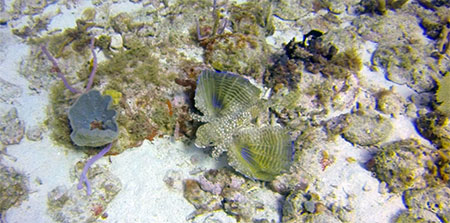
Should we go on the second morning dive as well, given that our plane left early the next day? Though our Uwatec dive computers showed just nine hours of no-fly time we decided to skip the last dive, with heavy hearts, to be closer to the generally recommended 24 hour no-fly rule. That also gave us extra time to take our dive gears on the upper deck for drying.
Jane's final lunch of the trip included cold cuts, cheese quiches, breaded fried shrimp, several cheeses, boiled eggs, and a variety of salads. During our meal, the Captain moved the boat from Monkey Shoals to the port at Basseterre where a giant cruise ship was also docked. I watched the challenge of properly approaching a crowded dock on a 110-foot liveaboard, slow down and turn, then align the boat with the dock and get close enough for having it fastened with three ropes. I can only imagine how difficult this is with a cruise ship.
In the afternoon we went on a ($30/person) tour of St. Kitts in Percy's blue Mitsubishi minivan. We knew Percy from our last trip. The man knows seemingly everyone on the island and always had a friendly question, an inquiry, or a kind word for everyone wherever we slowed down or stopped.
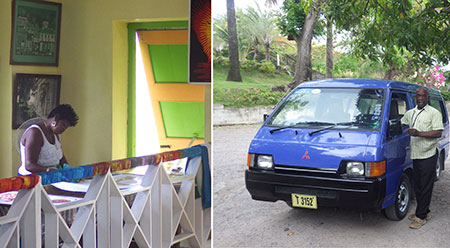
The tour took us through the center of Basseterre to its outskirts and the small settlements outside of town, past the St. Kitts Veterinary University, and some impressive churches from the era where the island had been divided into parishes.
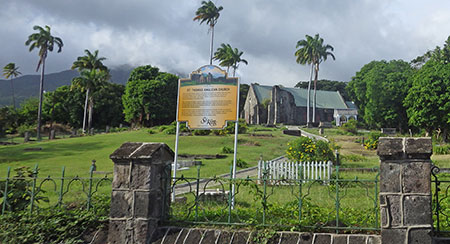
Cane sugar had been big business on St. Kitts, bringing fortune and riches to the island, but it was a cyclical business in the best of time, and one requiring high investment and reliance on a large labor force that at times consisted of indentured labor from Europe, other times on slave labor, and then, once slavery was abolished, on the work of those who had been freed.
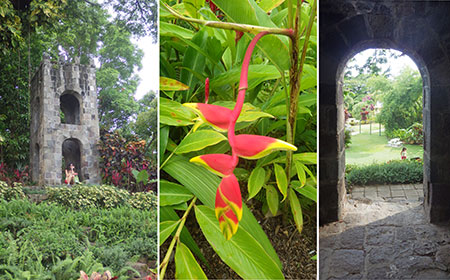
We visited a former sugar plantation that now houses, besides the partially rebuilt remnants of the sugar processing plant, also a famous Batik shop that we had not been able to visit last time because it was closed. This time it wasn't and they had nice things indeed. We bought several items, then had drinks at the attached outdoor bar and perused the most impressive rain forest surrounding and engulfing the property.
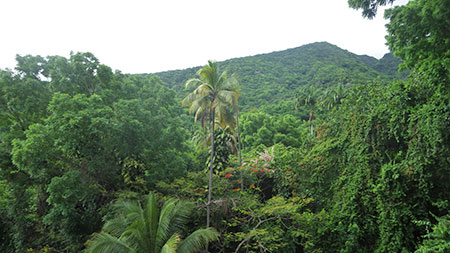
The forest, supposedly, had not been there during the sugar plantation era and had all sprung up in the last 100 years after the sugar plantation had long since closed down. I thought the massive lusciousness of the forest was interesting as I had read that the forest had been cut down to make room for sugar cane and had never properly grown back.
Then it was on to Brimstone fortress where, on the way up, we encountered herds of the little Velvet monkeys St. Kitts is famous for. They are small and very cute, and also quite shy. According to Percy, there are more monkeys on the island than people, though I am not quite sure how they ever counted the monkeys.
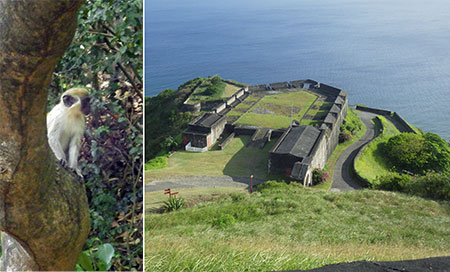
The fort itself was as impressive as I remembered (albeit perhaps in somewhat worse repair than it was four years ago) and an incredible architectural feat, given its location and engineering resources available at the time it was built. There were also a good number of exhibits explaining history, as well as customs and conditions at the time. I wish we'd had more time to take it all in.
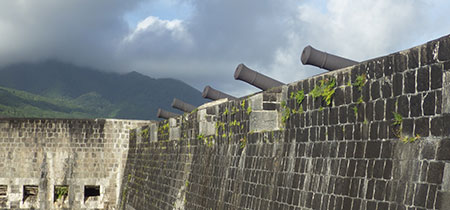
Overall, the entire island of St. Kitts is a fascinating place with as much history or more than any other island in the Caribbeans. The island has awesome natural beauty and seems near paradise, a fact perhaps a bit lost on some of today's population.
Driving back to the ship through the crowded streets of Basseterre was tiring, and once we arrived I no longer had any desire to go out and have dinner at a local restaurant. So Carol went and I stayed behind, first having a nice conversation with Jane the cook, then taking a hot shower and packing up the remainder of our gear and belongings.
Saturday, June 6, 2014 St. Kitts to Sacramento — The wakeup call came early at 5AM for our 7:40AM flight at the airport right outside of Basseterre. The trip was over much too soon and I missed the Caribbean Explorer II and our new friends onboard as soon as we stepped into Percy’s cab. It’d been great to experience this itinerary under weather conditions vastly better than we’d had four years prior. And I can't even begin to describe how impressed we were with the crew, which was not only supremely competent, but made us feel welcome, appreciated, and well cared for.
One bad thing about even the most wonderful dive trip is the travel involved. Getting there and getting back used to be half the fun, but not anymore. Not with airlines seemingly determined to make flying as uncomfortable and inconvenient as possible, and piling on ever more fees and extra charges. We flew back from St. Kitts to Miami where we had two hours between flights and needed every minute of it to make it through cumbersome immigrations, then on to Charlotte, way out of the way, and then a long final leg to Sacramento. By the time we were home we’d been up 22 hours, cranky, exhausted, and swearing we’d never, ever fly again.
But, of course, we will. And the airlines know it and will be ready with even more fees, even harder seats, and even less service and more inconvenience. And we’ll grin and bear it. Because we know that once we’re there we’ll have a great time.
Posted by conradb212 at July 15, 2014 10:19 PM








